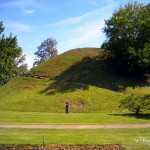
Moundsville, West Virginia (WV), the county seat of Marshall County, was chartered in 1832 and named on account of burial mounds on the Ohio River near the mouth of Grave Creek. The Grave Creek Mound and smaller mounds and earthworks were located in the city. Now listed on the National Register of Historic Places, the West Virginia State Penitentiary was founded in Moundsville in 1866. The West Virginia Archaeological Museum stands adjacent to the Grave Creek Mound.
Lodging near Moundsville, West Virginia

Parks & Public Recreation
The following parks and public recreation areas are located in and near Moundsville.
- Burches Run Wildlife Management Area
- Ohio River Islands National Wildlife Refuge
- Grand Vue Park
- Grave Creek Mound Park
- Marshall County Fairgrounds
- Methodist Park
- Riverside Park
- Valley Fork City Park
- Saint Jude Park (Glen Dale)
- Dowdell Park (Glen Dale)
Photos of Moundsville & Vicinity




Location
Moundsville is located on highway US-250 and WV-2, approximately 12 miles south of Wheeling, West Virginia, 20 miles northwest of Cameron, West Virginia, and 25 miles northeast of New Martinsville, West Virginia.
Map of Moundsville, West Virginia
Moundsville at a Glance
On the Ohio River, Moundsville is a small city with a long and layered history. Known primarily for its ancient burial mound and its once-notorious penitentiary, the town continues to evolve, striking a balance between its rich historical roots and efforts to build a more vibrant future.
At the center of town stands the Grave Creek Mound, the largest conical burial mound in North America. Raised more than 2,000 years ago, the earthwork serves as a reminder of some of the region’s early known inhabitants. Today, it is preserved by the state and managed as part of the Grave Creek Mound Archaeological Complex, which also includes a museum and research center.
Dr. Olivia Simms, an archaeologist and researcher at the complex, said the mound draws visitors and scholars from across the country. “It’s one of the few places where you can directly engage with prehistoric Native American history on this scale,” Simms said. “It’s an incredibly important piece of American heritage.”
The town was officially incorporated in 1832, and its name is a reflection of its most famous landmark. Over time, it developed as a center of commerce and transportation, thanks in part to its location along the Ohio River. By the late 19th century, it had become a hub for coal shipping, glass manufacturing, and other industries that supported the region’s economic growth.
Perhaps its most imposing structure is the West Virginia State Penitentiary, a Gothic-style prison that operated from 1876 to 1995. With its castle-like façade and history of riots and executions, the penitentiary gained a national reputation for both its architectural significance and its grim legacy. After it was decommissioned, the prison was transformed into a tourist attraction, offering historical and ghost tours.
Local guide Angela Morris said tourism at the penitentiary has increased steadily over the past decade. “People are fascinated by what went on inside these walls,” she said. “We get everyone from paranormal investigators to high school field trips.”
In addition to its historical attractions, the city is home to Grand Vue Park, a recreational facility offering hiking trails, zip lines, cabins, and panoramic views of the Ohio Valley. The park has become a key component of local tourism and a popular spot for outdoor activities.
Despite facing economic challenges in recent decades—particularly due to the decline of coal and industrial jobs—the community has witnessed small but meaningful signs of renewal. Local businesses, including cafes, restaurants, and antique stores, have opened in and around the downtown area. Community organizations have also invested in beautification efforts, festivals, and arts initiatives aimed at revitalizing the town.
“Moundsville has always been a resilient place,” said Mayor Phil Remke. “Our people take pride in where we’re from. We’re focused on building opportunities while preserving our heritage.”
The city has also received national attention through documentaries and books. The 2018 film Moundsville, directed by journalists David Bernabo and John W. Miller, examined the town’s history and its efforts to adapt to change in post-industrial America. The film has been featured in classrooms, community screenings, and film festivals.
For those planning a visit, the community offers a range of attractions within walking or short driving distance. The Grave Creek Mound is located at 801 Jefferson Avenue, adjacent to the former penitentiary, which is situated across the street. Grand Vue Park is just a few miles away and includes lodging and outdoor amenities.
Moundsville is located approximately 12 miles south of Wheeling and just over 70 miles southwest of Pittsburgh, making it accessible for day trips or weekend visits. Seasonal ferry service across the Ohio River also provides access to and from nearby Ohio towns.
With its blend of ancient heritage, historical landmarks, and Appalachian spirit, Moundsville remains a place of cultural significance and enduring presence.
Regional Information
Moundsville is located in the Northern Panhandle Region in northern West Virginia. Located just over an hour from Pittsburgh and a short drive from Wheeling, Moundsville is easily accessible for a day trip or weekend getaway. Visitors can explore the Grave Creek Mound, take a chilling tour of the West Virginia Penitentiary, or unwind in nature at Grand Vue Park.
Whether you're a history buff, a lover of small-town Americana, or simply curious about places where the past still speaks, the community offers its guests a unique and unforgettable experience. For more information on visiting, contact VisitMoundsville.com.




